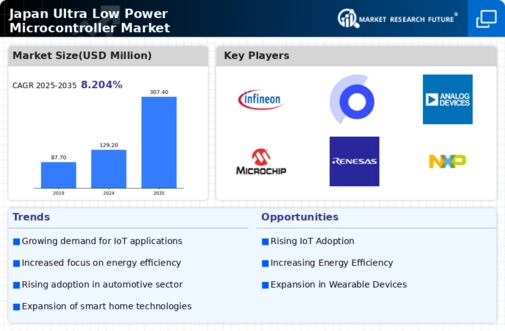Expansion of Smart Home Solutions
The rise of smart home technologies in Japan is significantly impacting the ultra low-power-microcontroller market. As households increasingly adopt smart devices, such as smart thermostats, security systems, and lighting controls, the demand for microcontrollers that operate efficiently with minimal energy consumption is on the rise. In 2025, the smart home market in Japan is expected to surpass $10 billion, highlighting the potential for growth in this sector. Ultra low-power microcontrollers are essential for ensuring that these devices can function continuously without frequent battery replacements. This trend indicates a shift towards more sustainable living solutions, further driving the need for advanced microcontroller technologies in the ultra low-power-microcontroller market.
Growing Adoption of Wearable Devices
The increasing popularity of wearable devices in Japan is driving the ultra low-power-microcontroller market. These devices, which include fitness trackers and smartwatches, require microcontrollers that consume minimal power to extend battery life. In 2025, the wearable technology market in Japan is projected to reach approximately $3 billion, indicating a robust demand for energy-efficient components. As consumers become more health-conscious, the need for advanced features in wearables, such as heart rate monitoring and GPS tracking, necessitates the use of ultra low-power microcontrollers. This trend suggests that manufacturers will continue to innovate, focusing on enhancing the performance of these microcontrollers while maintaining low power consumption, thereby propelling the ultra low-power-microcontroller market forward.
Advancements in Automotive Electronics
The automotive sector in Japan is undergoing a transformation with the integration of advanced electronics, which is influencing the ultra low-power-microcontroller market. As vehicles become more connected and autonomous, the need for energy-efficient microcontrollers is paramount. In 2025, the automotive electronics market is projected to reach $30 billion, with a significant portion dedicated to low-power solutions. These microcontrollers are crucial for managing various functions, including infotainment systems, navigation, and safety features, all while minimizing energy consumption. This trend suggests that manufacturers will increasingly focus on developing ultra low-power microcontrollers tailored for automotive applications, thereby enhancing the overall efficiency of vehicles.
Rising Demand for Smart Agriculture Solutions
The agricultural sector in Japan is increasingly adopting smart technologies, which is positively impacting the ultra low-power-microcontroller market. With the need for precision farming and efficient resource management, farmers are turning to IoT-enabled devices that require low-power microcontrollers. These devices facilitate real-time monitoring of soil conditions, crop health, and weather patterns, thereby optimizing agricultural practices. In 2025, the smart agriculture market in Japan is projected to reach $1 billion, reflecting a growing interest in technology-driven farming solutions. This trend suggests that the ultra low-power-microcontroller market will benefit from the increasing integration of smart technologies in agriculture, promoting sustainability and productivity.
Increased Focus on Environmental Sustainability
Japan's commitment to environmental sustainability is driving innovation in the ultra low-power-microcontroller market. As industries strive to reduce their carbon footprint, there is a growing emphasis on energy-efficient technologies. The government has set ambitious targets for reducing greenhouse gas emissions, which encourages companies to adopt ultra low-power microcontrollers in their products. This shift not only aligns with regulatory requirements but also meets consumer demand for eco-friendly solutions. In 2025, the market for green technologies in Japan is expected to grow significantly, indicating a strong potential for ultra low-power microcontrollers that support sustainable practices. This trend highlights the importance of integrating energy-efficient components into various applications.
























Leave a Comment